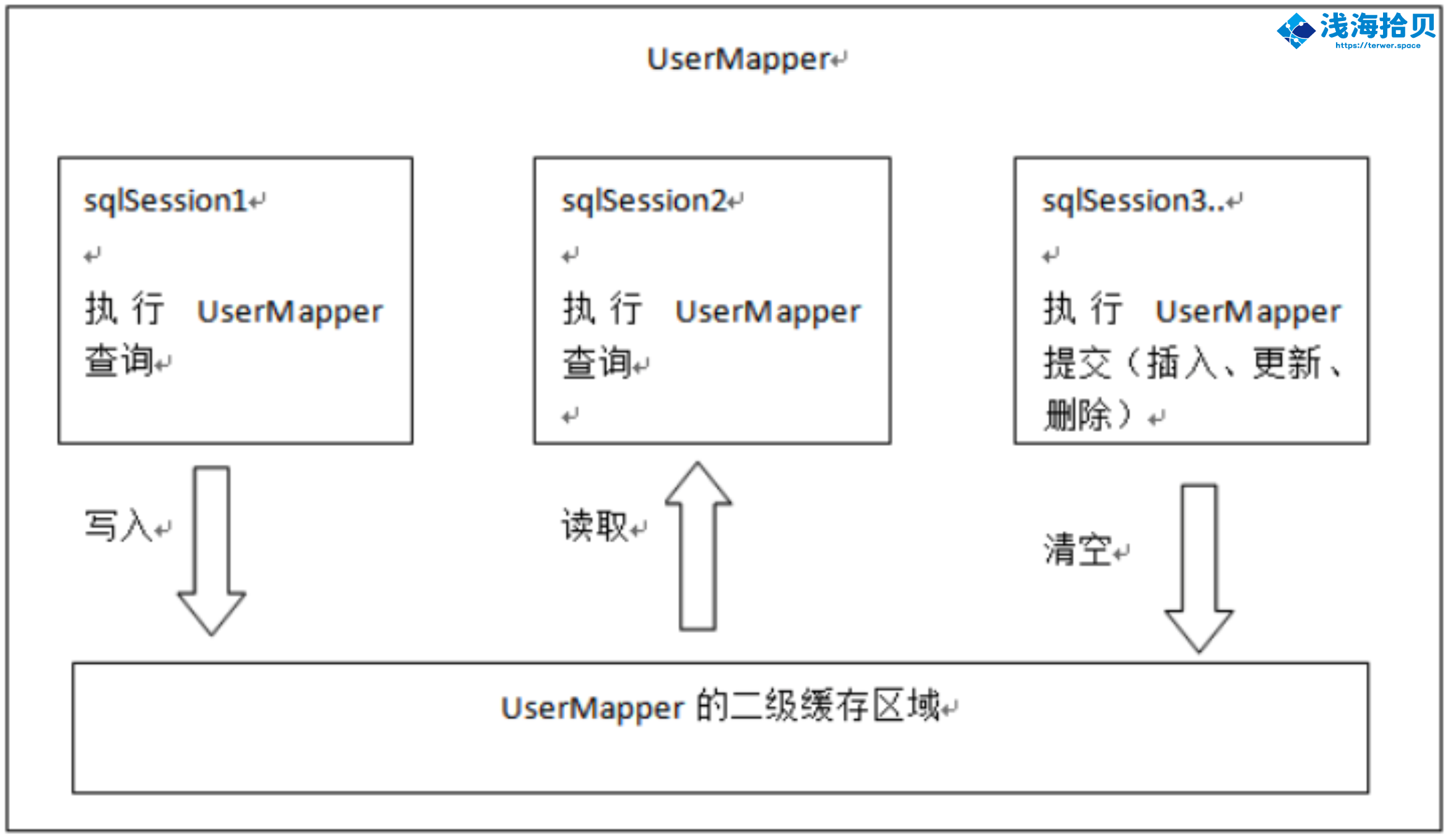二级缓存的原理
-
MyBatis 二级缓存的原理是什么?文章源自浅海拾贝-https://blog.terwergreen.com/mybatis-s-secondary-cache-z2ssaab.html
- 二级缓存的原理和一级缓存一样,第一次查询会将数据放到 缓存 中,然后第二次查询直接去缓存读取。
- 但是一级缓存是基于 SqlSession 的,二级缓存是基于 mapper 的 namespace 的。
- 也就是说,多个 SqlSession 可以共享同一个二级缓存区域。如果两个 mapper 的 namespace 相同,那么即使是两个 mapper,这两个 mapper 执行 sql 查询的数据也将保存在相同的二级缓存区域中。
 文章源自浅海拾贝-https://blog.terwergreen.com/mybatis-s-secondary-cache-z2ssaab.html
文章源自浅海拾贝-https://blog.terwergreen.com/mybatis-s-secondary-cache-z2ssaab.html
如何使用二级缓存
注意:User 需要实现序列化接口。文章源自浅海拾贝-https://blog.terwergreen.com/mybatis-s-secondary-cache-z2ssaab.html
开启二级缓存
和一级缓存不一样,二级缓存需要手动开启。文章源自浅海拾贝-https://blog.terwergreen.com/mybatis-s-secondary-cache-z2ssaab.html
首先在全局配置文件 sqlMapConfig.xml 中加入如下代码文章源自浅海拾贝-https://blog.terwergreen.com/mybatis-s-secondary-cache-z2ssaab.html
<settings>
<!-- 开启二级缓存 -->
<setting name="cacheEnabled" value="true"/>
</settings>
然后在 UserMapper.xml 中开启二级缓存。文章源自浅海拾贝-https://blog.terwergreen.com/mybatis-s-secondary-cache-z2ssaab.html
<!-- 开启二级缓存 -->
<cache />
如果是使用注解方式,在 IUserMapper 上写上注解 @CacheNamespace文章源自浅海拾贝-https://blog.terwergreen.com/mybatis-s-secondary-cache-z2ssaab.html
@CacheNamespace
public interface IUserMapper {
}
测试代码文章源自浅海拾贝-https://blog.terwergreen.com/mybatis-s-secondary-cache-z2ssaab.html
public class SecondCacheTest {
private SqlSessionFactory sqlSessionFactory;
@Before
public void before() throws Exception {
InputStream resourceAsStream = Resources.getResourceAsStream("sqlMapConfig.xml");
sqlSessionFactory = new SqlSessionFactoryBuilder().build(resourceAsStream);
}
@Test
public void secondLevelCache() {
SqlSession sqlSession1 = sqlSessionFactory.openSession();
SqlSession sqlSession2 = sqlSessionFactory.openSession();
IUserMapper userMapper1 = sqlSession1.getMapper(IUserMapper.class);
IUserMapper userMapper2 = sqlSession2.getMapper(IUserMapper.class);
User user1 = userMapper1.findUserById(1);
// 清空一级缓存
sqlSession1.close();
User user2 = userMapper2.findUserById(1);
System.out.println(user1 == user2);
}
}
效果如下文章源自浅海拾贝-https://blog.terwergreen.com/mybatis-s-secondary-cache-z2ssaab.html
Setting autocommit to false on JDBC Connection [com.mysql.cj.jdbc.ConnectionImpl@56528192]
==> Preparing: select * from user where id=?
==> Parameters: 1(Integer)
<== Columns: id, username, password, birthday
<== Row: 1, lucy, 123, 2019-12-12
<== Total: 1
Resetting autocommit to true on JDBC Connection [com.mysql.cj.jdbc.ConnectionImpl@56528192]
Closing JDBC Connection [com.mysql.cj.jdbc.ConnectionImpl@56528192]
Returned connection 1448247698 to pool.
As you are using functionality that deserializes object streams, it is recommended to define the JEP-290 serial filter. Please refer to https://docs.oracle.com/pls/topic/lookup?ctx=javase15&id=GUID-8296D8E8-2B93-4B9A-856E-0A65AF9B8C66
Cache Hit Ratio [com.terwergreen.mapper.IUserMapper]: 0.5
false
可以看到,两次请求,只有第一次输出了 sql , 并且输出了缓存命中率是 0.5 。文章源自浅海拾贝-https://blog.terwergreen.com/mybatis-s-secondary-cache-z2ssaab.html
useCache 和 flushCache
- useCache 用来设置是否禁用二级缓存。在 statement 中设置 useCache="false" 可以禁用当前 select 语句的 二级缓存
-
<select id="selectUserByUserId" useCache="false" resultType="space.terwer.pojo.User" parameterType="int"> select * from user where id=#{id} </select> - 设置 statement 的 flushCache="true" 即 刷新缓存 ,默认情况下就是 true。因为一般不设置,默认即可
-
注解方式的使用文章源自浅海拾贝-https://blog.terwergreen.com/mybatis-s-secondary-cache-z2ssaab.html
/** * 根据ID查询用户 * * @param id * @return */ @Options(useCache = false, flushCache = Options.FlushCachePolicy.TRUE) @Select("select * from user where id=#{id}") User findUserById(Integer id);
文章更新历史文章源自浅海拾贝-https://blog.terwergreen.com/mybatis-s-secondary-cache-z2ssaab.html
2024/05/15 同步文章到其他平台文章源自浅海拾贝-https://blog.terwergreen.com/mybatis-s-secondary-cache-z2ssaab.html
2022-12-25 feat: 初稿 文章源自浅海拾贝-https://blog.terwergreen.com/mybatis-s-secondary-cache-z2ssaab.html
文章源自浅海拾贝-https://blog.terwergreen.com/mybatis-s-secondary-cache-z2ssaab.html
MyBatis的二级缓存是基于mapper的namespace的,多个SqlSession可以共享同一个二级缓存区域。使用二级缓存需要手动开启,并且可以通过useCache和flushCache属性来控制缓存的使用和刷新。文章源自浅海拾贝-https://blog.terwergreen.com/mybatis-s-secondary-cache-z2ssaab.html
- 扫码加我微信
- 验证消息请输入:来自你的博客
-

- 我的微信公众号
- 微信扫一扫与我交流吧
-



评论